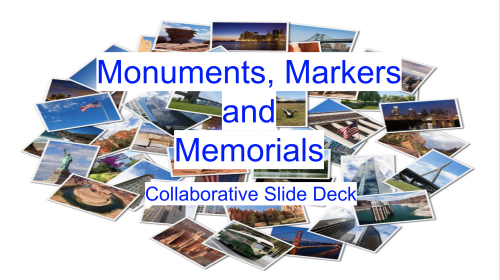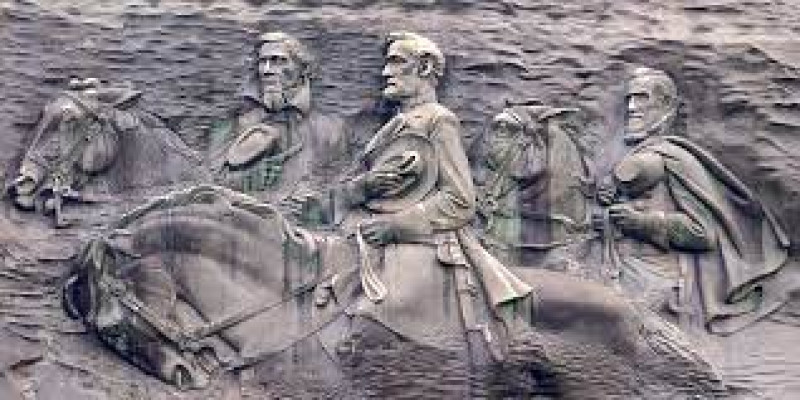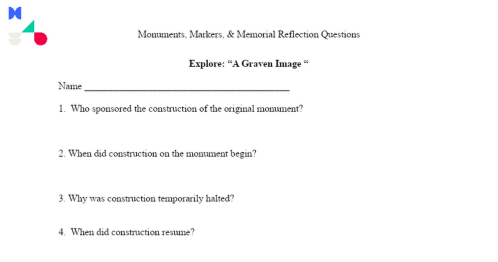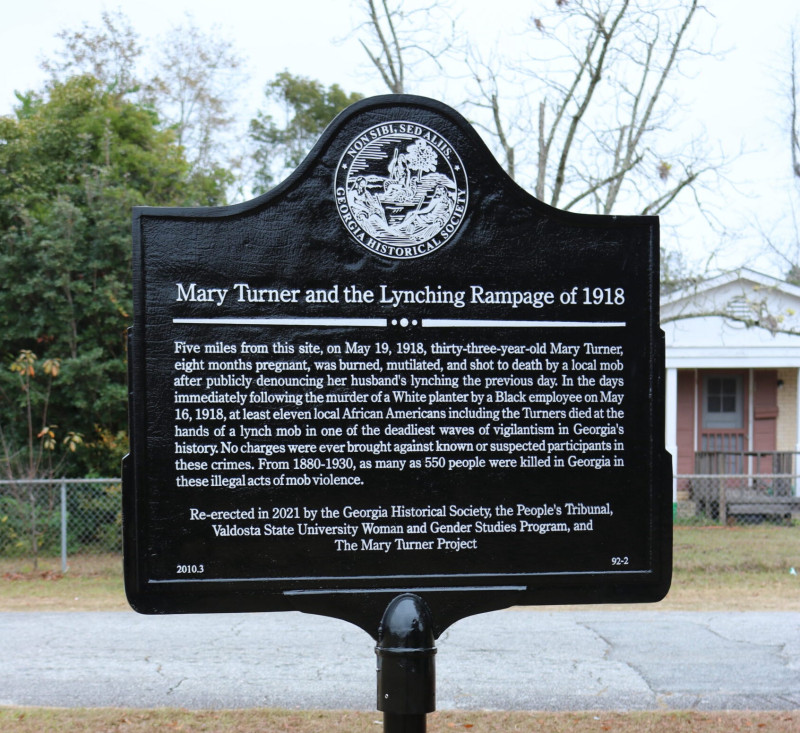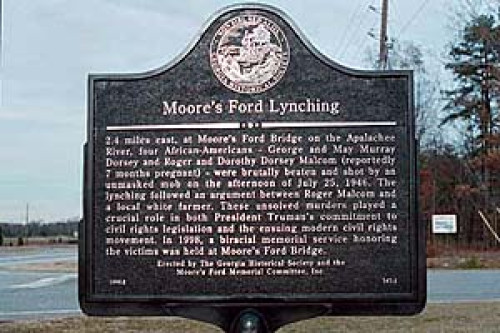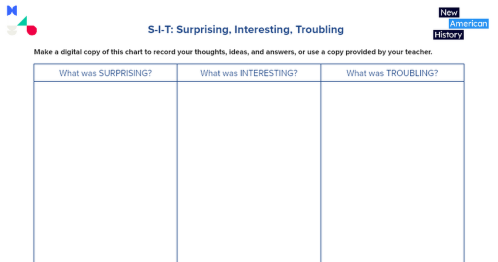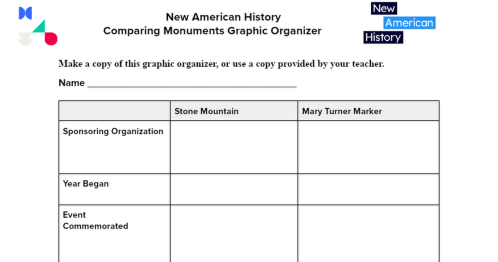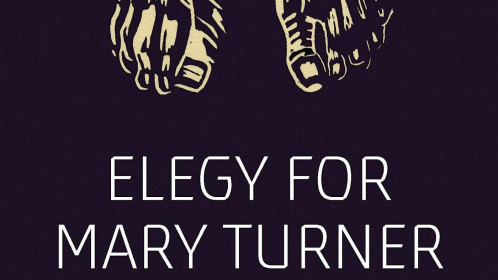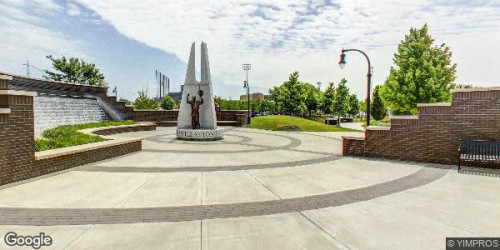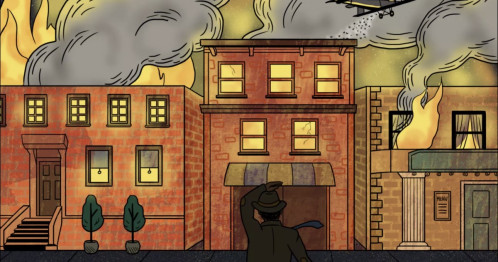This work by New American History is licensed under a Attribution-NonCommercial-ShareAlike 4.0 (CC BY-NC-SA 4.0) International License. Permissions beyond the scope of this license may be available at newamericanhistory.org.
Monuments, Markers, and Memorials
Read for Understanding
Building historical empathy as a learner
You have probably seen many monuments, memorials, and historical markers in your local community or when traveling. Sometimes these public historyicons are so obscure that we pass them by without “listening to” their stories at all. Others are so familiar that we don’t even think about the stories they tell. These learning resources will give you an opportunity to think about how communities choose to remember and memorialize people, places, and events, and how our thinking may change over time about these decisions.
Key Vocabulary
Commemorate - to honor the memory of a person or event
Icon - a widely known symbol or image, or a well-known/admired person
Iconography - the images and symbols associated with a person, a group, or a movement
Juxtaposition - the placement of two (or more) items next to each other in order to compare them or call attention to them
Klaven - a local unit of the Ku Klux Klan
Ku Klux Klan - a white supremacist group founded in 1865 to intimidate African Americans and other minority groups from asserting themselves in any way, including politically
Lynching - killing of someone accused of wrongdoing without using the legal system; usually carried out by a mob
Marker – a sign erected to call attention to a place or event
Memorialize - to preserve the memory of; to celebrate publicly
Monument - a statue, plaque, building, work of art, or other honor created to memorialize or commemorate a person, place, or event, or to tell a specific story
Perpetrator - a person who commits an unkind or illegal act
Public history - the interpretation and/or presentation of history for an audience of non-specialists, performed outside of traditional classroom settings (for example, in a museum)
Reconstruction - the period after the Civil War, from about 1865-1877, when the federal government passed civil rights legislation and attempted to re-integrate the southern states into the nation
Sponsor - to pay for something to be created; to financially support or sustain
Tenant farming - an agricultural system under which one person (tenant) rents land from an owner (landlord), and provides his own tools, seeds, and labor; the rent on the land could be paid in cash or in produce
Engage:
What American stories do you already know from public history artifacts on the physical landscape?
You have probably seen many monuments, memorials, and historical markers–maybe even in your local community. Sometimes these public history icons are so obscure that we pass them by without “listening to” their stories at all. Others are so familiar that we don’t even think about the stories they tell.
Make a copy of these collaborative slides.
Use the speaker notes feature to take notes as you analyze each image of public history on the American landscape. As you view the collection of images, think about the following questions for each one and jot down your ideas.
- Identify the name of this monument/memorial (or a description if you are unable to identify it).
- Does this monument/memorial honor an event, a person, or a group? (include all that apply]
- What is the monument or memorial’s relative size?
- What elements of the monument or memorial seem to be heroic or noble? (include examples)
- What elements of the monument or memorial seem to be humble or mournful?
In this lesson, you will be exploring stories told by some other monuments and markers in Georgia. One is a well-known monument, and the other is a local public history marker that is probably less familiar to most people. Later, you will have an opportunity to design a monument or marker to tell a local history story of your choosing. In order to prepare for the exploration ahead, you will first need to recall some stories you may have already heard.
Spend a few minutes independently to generate a list of what you know or think you know about each of the following:
- Reconstruction
- tenant farming
- lynching
- Ida B. Wells
- Stone Mountain
Turn and talk to a partner as directed by your teacher. If working remotely, your teacher may allow you to use breakout rooms through videoconferencing or share via a collaborative document such as Google Docs or Google Slides.
Next, explore each of these words, names, or places in Bunk. Bunk is a site that helps us make historical connections.
- When you search in Bunk for each word, name, or place from your list, what results do you and your partner see?
- How many items are currently in Bunk for each word, name, or place?
- What other tags are associated with each item on the list?
- What surprised you, or what patterns do you see now?
Add your answers to your original list and discuss what you found with your partner.
Your teacher may ask you to record your answers on an exit ticket.
Explore:
How are two related but vastly different stories told through the public monuments that commemorate them?
Explore these two stories related to two public monuments/markers and how their stories are told. The first monument is a somewhat (in)famous one located at a state park in Georgia. The second story is much more local to one community in that state. As you explore these monuments and markers, think about the stories that they tell . . . and those they leave untold.
Much has been written in recent years as many cities across the country have engaged in conversations or taken action to remove Confederate iconography. Use the bulleted list below to consider this Confederate memorial located at Stone Mountain, Georgia. You may want to explore this Bunk tag as you respond to the questions independently.
- Give the name of this monument/memorial and a description
- Does this monument honor an event, a person, or a group? [Include all that apply]
- What is the monument’s relative size? [life-sized, large, very-large, small]
- What elements of the monument seem to be heroic or noble?
- What elements of the monument seem to be humble or mournful?
Turn and talk to a partner as directed by your teacher. If working remotely, your teacher may allow you to use breakout rooms through videoconferencing or share via a collaborative document such as a Google Doc or Google Slides.
After you and your classmates have completed sharing, make a copy of the “Graven Image” Reflection Questions, and review the questions before you view the video, Graven Image, as shared in Bunk. In your first viewing, do not do any writing, but instead, focus your attention on the video. Watch the video a second time, and respond to each question.
After you have completed your video exploration of Stone Mountain, turn and talk to a partner as directed by your teacher. If working remotely, your teacher may allow you to use breakout rooms through videoconferencing or share via a collaborative document such as Google Docs or Google Slides.
Next, explore a less familiar story. Take a few minutes to read and analyze this image of a historical marker:
Explore this entry on lynching in the New Georgia Encyclopedia. From the sidebar menu, select “Notorious Lynchings.” Scroll down to read the Mary Turner story.
When you finish viewing both the video and the readings, complete the Facing History S-I-T graphic organizer to reflect on what you have learned.
Your teacher may ask you to record your answers as an exit ticket.
Explain:
How might some monuments be related, even though they memorialize very different people or events?
Now that you have learned about these two monuments and the events that they commemorate, you will consider and explore some deeper questions about each. First, view and analyze these three maps: (Note: due to the sensitive historical content, your teacher may choose to have you analyze only 1 or 2 of the maps.)
- What does the date 1915 – and the title “Second Ku Klux Klan” – have to do with Stone Mountain, Georgia?
- How many “Klavens” are shown on this map for metropolitan Atlanta?
- How many “Klavens” are shown on this map for the whole state of Georgia?
- Is there a “Klaven” whose home is actually in Stone Mountain, Georgia?
Use the search box on this map to locate and zoom in on the carving at Stone Mountain, Georgia.
- In addition to the actual carving, how many other physical memorials (such as statues) are there within Stone Mountain Park?
- What do you notice about the street names within the park?
- How does this information reinforce or otherwise affect your understanding of the park’s main purpose?
- Did the Mary Turner lynching take place within the time period shown on this map?
- Zoom in to Brooks County, Georgia. How many documented lynchings took place here during the time period covered by the map?
Using your previous reflections and discussion notes, complete this Comparing Monuments graphic organizer summarizing what you have learned. You will save the last row until later, and revisit it during the “Elaborate” section of this learning resource.
Your teacher may ask you to share your graphic organizer as an exit ticket.
Elaborate:
What stories are these monuments telling now, and how might they be interpreted in the future?
Finally, you will explore what has happened more recently to these historical monuments, and help predict how future generations might interpret them.
Select one or more of the following articles or excerpts, as directed by your teacher. Make a copy of the Monuments, Markers, and Memorials Reading Graphic Organizer, or use a copy provided by your teacher. As you read, complete each section of the graphic organizer for the excerpts or articles you read.
Return to the Comparing Monuments graphic organizer from the “Explain” section of this learning resource and complete the last row, using the new information you have gathered.
Finally, complete these Final Reflection questions using the space below on page 2 of the graphic organizer:
- How does examining two very different memorials influence your viewpoint about historical events?
- Are there memorials that you think should be included in or excluded from public history? Explain your answer.
- What factors do you think a group of citizens should consider in the process of commissioning, designing, approving, funding, and erecting a memorial on public land?
Your teacher may ask you to record your answers on an exit ticket.
Extend:
What public history story would you like to tell, and how would you tell it?
Artist Rachel Marie-Crane Williams created a series of prints (later published as a book) depicting the Mary Turner lynching story. View the artist’s series and read “An Author Replies To The Unspeakable In Her 'Elegy' For Lynching Victim Mary Turner,” a review of the book on NPR.
(Note: This artist’s interpretation of these events may be difficult for you as a student to view. Your teacher will guide you through this activity as you are comfortable with the content. An alternate learning experience is offered below.)
Alternate learning experience: Analyze this image of the “Tower of Reconciliation,” a sculpture created by artist Ed Wright for the John Hope Franklin Reconciliation Park. Explore the sculpture further via this interactive 3D panoramic tour.
The park memorializes the Tulsa Race Massacre. Explore this graphic narrative from The Nib as excerpted in Bunk to learn more about this topic.
Afterward, think of a historical event for which you would like to create a monument, memorial, or marker. Create that piece of art or describe it through a mode agreed upon by you and your teacher (example: draw/paint, compose music, create a sculpture or mixed media collage, etc.) Consider the following criteria to help plan your project.
- Why do you think the story is important?
- What artistic medium will you use to best communicate the story?
- Why did you select this form of artistic expression?
- What size will the artwork be?
- Where will you display or publish it?
- How will you let the public know about this piece of art?
We would love to see what you created - please share your work if your teacher or a trusted adult permits. You may email us at editor@newamericanhistory.org or share via social media (links on our pages). Be sure to tag us as you share!
Your teacher may ask you to record your answers on an exit ticket.
Citations:
Bentley, Rosalind, and James Beard. 2021. “Defaced sign honoring Georgia lynching victim going to human rights center.” Atlanta Journal-Constitution. https://www.ajc.com/life/defaced-sign-honoring-georgia-lynching-victim-going-to-human-rights-center/5CM7JCVW7VBQRATEWO2M3H6VQQ/.
Boissoneault, Lorraine. “What Will Happen to Stone Mountain, America's Largest Confederate Memorial?” Bunk History. New American History, July 6, 2022. https://www.bunkhistory.org/resources/what-will-happen-to-stone-mountain-americas-largest-confederate-memorial
Buder, Emily. “The Painful History of a Confederate Monument Tells Itself.” Bunk History. New American History, December 1, 2017.. https://www.bunkhistory.org/resources/1522.
“Explore The Map | Lynching In America.” Lynching in America: Confronting the Legacy of Racial Terror. Equal Justice Initiative, April 2021. https://lynchinginamerica.eji.org/explore
”The Imposed Racial Etiquette: A Tulsa Postcard • New American History.” New American History. July 2, 2022. .https://resources.newamericanhistory.org/sf-a-tulsa-postcard.
2022. Georgiahistory.com. 2022. https://georgiahistory.com/wp-content/uploads/2021/12/Mary-Turner-and-the-Lynching-Rampage-of-1918-scaled.jpg.
“John Hope Franklin Reconciliation Park.” PanoWalks. August 23, 2022. https://panowalks.com/embed/7izaQPRaovbF5JjZm8KtkyrzkzD4/.
Lehoczky, Etelka. 2021. “An Author Replies To The Unspeakable In Her 'Elegy' For Lynching Victim Mary Turner.” NPR. https://www.npr.org/2021/03/17/975960845/an-author-replies-to-the-unspeakable-in-her-elegy-for-lynching-victim-mary-turner.
“Lynching.” New Georgia Encyclopedia. Accessed August 18, 2022. https://www.georgiaencyclopedia.org/articles/history-archaeology/lynching/.
“Mapping the Second Ku Klux Klan, 1915-1940 | Labs@VCU Libraries.” VCU Libraries Labs. Accessed August 18, 2022. https://labs.library.vcu.edu/klan/.
Meyers, Christopher. 2006. “Killing Them By the Wholesale: A Lynching Rampage in South Georgia.” Georgia Historical Quarterly 90, no. no. 2 (summer): 214-235. June 2006.
Poling, Dean. 2021. “Vandalized Mary Turner marker to be displayed in Atlanta.” Valdosta Daily Times. https://www.valdostadailytimes.com/news/vandalized-mary-turner-marker-to-be-displayed-in-atlanta/article_669ed62c-a5ec-11eb-9d49-4b2361c97b52.html.
Pratt, Timothy, and Rick Rojas. 2021. “Giant Confederate Monument Will Remain at Revamped Stone Mountain.” The New York Times, May 24, 2021, sec. U.S. https://www.nytimes.com/2021/05/24/us/stone-mountain-confederate-monument-georgia.html.
Stewart, Bruce E. n.d. “Stone Mountain.” New Georgia Encyclopedia. Accessed August 15, 2022. https://www.georgiaencyclopedia.org/articles/geography-environment/stone-mountain/.White, Jonathan W., Scott Sandage, and Scott A. Sandage. 2020. “What Frederick Douglass Had to Say About Monuments.” Smithsonian Magazine. July 6, 2022https://www.smithsonianmag.com/history/what-frederick-douglass-had-say-about-monuments-180975225/.
Williams, Josh. 2021. “What the 1921 Tulsa Race Massacre Destroyed.” The New York Times. https://www.nytimes.com/interactive/2021/05/24/us/tulsa-race-massacre.html.


